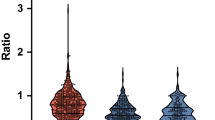Abstract
Among the many exciting developments in the study of the behavior of contrast media [4], little attention has been paid to the suggested correlation of the iodinated agents with thyroid hormone physiology. To what extent could the accumulation of iodinated drugs influence the thyroid metabolism? Although some data indicate that minimal absorption of free iodine generally occurs [3], we have not yet elucidated the interrelationship of the absorption, distribution, binding, and biotransformation of the amount of iodide contained in an ordinary contrast media dose. During the recent past years few studies have reported certain changes in circulating iodo-thyronines in several groups of subjects given different contrast media [1, 5]. A better insight of hormonal status could be achieved with the measurements of free fractions of thyroid hormones. We therefore decided to carry out a prospective study of the hormonal trends during the 3 months after contrast media administration.
Access this chapter
Tax calculation will be finalised at checkout
Purchases are for personal use only
Preview
Unable to display preview. Download preview PDF.
Similar content being viewed by others
References
Burgi H, Wimpfheimer C, Burger A, Zaunbauer W, Rosler H, Lemachand-Beraud T (1976) Changes of circulating tiroxine triiodotyronine and reverse triiodiothyronine after radiographic contrast agents. J Clin Endocrinol Metab 43:1203
De Groot LJ, Rue PA (1979) Roentgenografic contrast agent inhibit triiodothyronine binding to nuclear receptors “in vitro”. J Clin Endocrinol Metab 49:4:538–542
Savoie JC, Massin JP, Thomopoulos P, Leger F (1975) Iodine induced thyrotoxicosis in apparently normal thyroid glands. JCE & M, vol 41, 4:685–691
Sternthal E, Lipworth L, Stanley B, Abreau C, Fang SL, Braverman LE (1980) Suppression of thyroid radioiodine uptake by various doses of stable iodide. The New England Journal of Medicine vol 303, 19:1083–1088
Yonckheer MH, Blockx P, Broeckaert I, Cornette C, Beckers C (1978) “Low T3 Sindrome” in patients chronically treated with au yodine. Containing drug, amiodarone. Clinical Endorinology 9:27–35
Editor information
Editors and Affiliations
Rights and permissions
Copyright information
© 1982 Springer-Verlag Berlin Heidelberg
About this paper
Cite this paper
Piffanelli, A. et al. (1982). Iodinated Compound and Thyroid Status. In: Amiel, M. (eds) Contrast Media in Radiology. Springer, Berlin, Heidelberg. https://doi.org/10.1007/978-3-642-68584-2_54
Download citation
DOI: https://doi.org/10.1007/978-3-642-68584-2_54
Publisher Name: Springer, Berlin, Heidelberg
Print ISBN: 978-3-540-11534-2
Online ISBN: 978-3-642-68584-2
eBook Packages: Springer Book Archive




